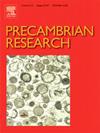High-resolution chemostratigraphy reveals a large δ13C gradient in the ∼ 1.56 Ga redox-stratified ocean
IF 3.2
2区 地球科学
Q2 GEOSCIENCES, MULTIDISCIPLINARY
引用次数: 0
Abstract
Reports of decimeter-scale eukaryotic fossils and oxygenation events in the Gaoyuzhuang Formation (∼1.56 Ga, North China Craton) have provided valuable insight into potential links between life and the environment during the early Mesoproterozoic. However, the detailed nature of this relationship remains unclear, partly due to a limited basin-wide stratigraphic framework. Here, we present high-resolution carbon isotope compositions for carbonate and organic matter (δ13Ccarb and δ13Corg) in two fossil-hosting sections, representing shallow and deeper water settings, to calibrate the timing of marine oxygenation and eukaryotic evolution, and to reveal coeval carbon cycle dynamics. Our high-resolution data display a dynamic δ13Ccarb pattern with four perturbations in Gaoyuzhuang members III-IV, and suggest a causal link between oxygenation and eukaryotic evolution during the second perturbation. The δ13Ccarb values exhibit a narrow range, but a distinct ∼ 2.5 ‰ isotopic gradient exists between shallow and deeper water during the third perturbation. By contrast, δ13Corg values reflect a more stable, but larger, isotopic gradient (∼7‰), implying decoupling of the carbon isotopic system. We propose that the δ13Corg compositions of shallow and deeper waters were controlled by specific microbial communities in a redox-stratified water column and a larger deep-ocean DOC reservoir, whereas δ13Ccarb sensitivity was buffered by a large DIC reservoir. Our modeling also highlights that the coeval oxygenation events were able to drive the observed short-term δ13Ccarb gradient during the third perturbation. Our findings reveal a direct relationship between environmental change and eukaryotic evolution, with implications for understanding Mesoproterozoic carbon cycle dynamics and paleo-redox conditions.
高分辨率化学地层学显示,在~ 1.56 Ga氧化还原层状海洋中存在较大的δ13C梯度
华北克拉通高玉庄组(~ 1.56 Ga)分米尺度真核生物化石和氧化事件的报道,为研究中元古代早期生命与环境之间的潜在联系提供了有价值的见解。然而,这种关系的详细性质仍然不清楚,部分原因是由于有限的全盆地地层格架。在此,我们在代表浅水和深水环境的两个化石承载剖面中获得了碳酸盐和有机质的高分辨率碳同位素组成(δ13Ccarb和δ13Corg),以校准海洋氧合和真核生物进化的时间,并揭示同期的碳循环动力学。我们的高分辨率数据显示了高玉庄III-IV段4次扰动的动态δ13Ccarb模式,并表明第二次扰动期间氧化作用与真核生物进化之间存在因果关系。在第三次扰动期间,δ13Ccarb值范围窄,但在浅水和深水之间存在明显的~ 2.5‰的同位素梯度。相比之下,δ13Corg值反映了一个更稳定,但更大的同位素梯度(~ 7‰),表明碳同位素体系的解耦。我们认为浅水和深水δ13Corg组成受氧化还原层状水柱和较大深海DOC储层中特定微生物群落的控制,而δ13Ccarb敏感性受大型DIC储层的缓冲。我们的模型还强调,在第三次扰动期间,同时期的氧化事件能够驱动观测到的短期δ13Ccarb梯度。我们的发现揭示了环境变化与真核生物进化之间的直接关系,对理解中元古代碳循环动力学和古氧化还原条件具有重要意义。
本文章由计算机程序翻译,如有差异,请以英文原文为准。
求助全文
约1分钟内获得全文
求助全文
来源期刊

Precambrian Research
地学-地球科学综合
CiteScore
7.20
自引率
28.90%
发文量
325
审稿时长
12 months
期刊介绍:
Precambrian Research publishes studies on all aspects of the early stages of the composition, structure and evolution of the Earth and its planetary neighbours. With a focus on process-oriented and comparative studies, it covers, but is not restricted to, subjects such as:
(1) Chemical, biological, biochemical and cosmochemical evolution; the origin of life; the evolution of the oceans and atmosphere; the early fossil record; palaeobiology;
(2) Geochronology and isotope and elemental geochemistry;
(3) Precambrian mineral deposits;
(4) Geophysical aspects of the early Earth and Precambrian terrains;
(5) Nature, formation and evolution of the Precambrian lithosphere and mantle including magmatic, depositional, metamorphic and tectonic processes.
In addition, the editors particularly welcome integrated process-oriented studies that involve a combination of the above fields and comparative studies that demonstrate the effect of Precambrian evolution on Phanerozoic earth system processes.
Regional and localised studies of Precambrian phenomena are considered appropriate only when the detail and quality allow illustration of a wider process, or when significant gaps in basic knowledge of a particular area can be filled.
 求助内容:
求助内容: 应助结果提醒方式:
应助结果提醒方式:


